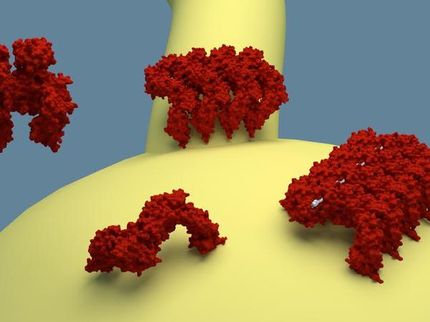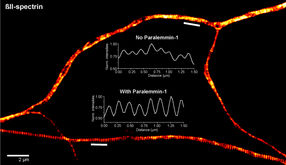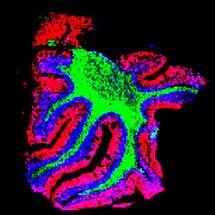Nanoscale Velcro used for Molecule Transport
Biological membranes are like a guarded border. They separate the cell from the environment and at the same time control the import and export of molecules. The nuclear membrane can be crossed via many tiny pores. Scientists at the Biozentrum and the Swiss Nanoscience Institute at the University of Basel, together with an international team of researchers, have discovered that proteins found within the nuclear pore function similar to a velcro. In “Nature Nanotechnology”, they report how these proteins can be used for controlled and selective transport of particles.
There is much traffic in our cells. Many proteins, for example, need to travel from their production site in the cytoplasm to the nucleus, where they are used to read genetic information. Pores in the nuclear membrane enable their transport into and out of the cell nucleus. The Argovia Professor Roderick Lim, from the Biozentrum and the Swiss Nanoscience Institute at the University of Basel, studies the biophysical basics of this transport. In order to better understand this process, he has created an artificial model of the nuclear pore complex, together with scientists from Lausanne and Cambridge, which has led to the discovery that its proteins function like a nanoscale “velcro” which can be used to transport tiniest particles.
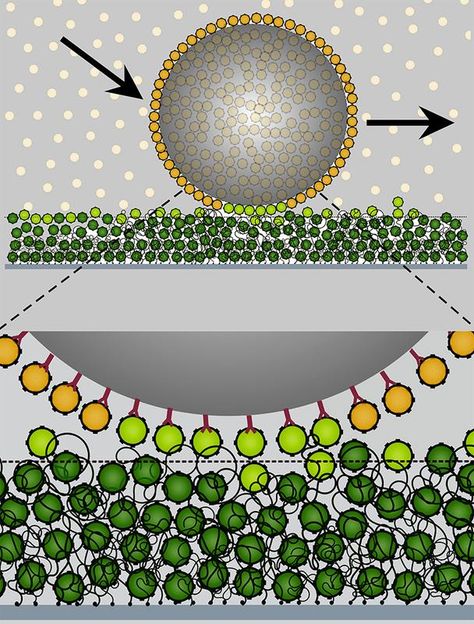
Import protein coated molecule moving on the “dirty velcro”.
University of Basel
“Dirty velcro” inside the nuclear pore
Nuclear pores are protein complexes within the nuclear membrane that enables molecular exchange between the cytoplasm and nucleus. The driving force is diffusion. Nuclear pores are lined with “velcro” like proteins. Only molecules specially marked with import proteins can bind to these proteins and thus pass the pore. But for all non-binding molecules the nuclear pore acts as a barrier. The researchers postulated that transport depends on the strength of binding to the “velcro” like proteins. The binding should be just strong enough that molecules to be transported can bind but at the same time not too tight so that they can still diffuse through the pore.
In an artificial system recreating the nuclear pore, the researchers tested their hypothesis. They coated particles with import proteins and studied their behavior on the molecular “velcro”. Interestingly, the researchers found parallels in behavior to the velcro strip as we know it. On “clean velcro”, the particles stick immediately. However, when the “velcro” is filled or “dirtied” with import proteins, it is less adhesive and the particles begin to slide over its surface just by diffusion. “Understanding how the transport process functions in the nuclear pore complex was decisive for our discovery,” says Lim. “With the nanoscale ‘velcro’ we should be able to define the path to be taken as well as speed up the transport of selected particles without requiring external energy.”
Potential lab-on-a-chip technology applications
Lim's investigations of biomolecular transport processes form the basis for the discovery of this remarkable phenomenon that particles can be transported selectively with a molecular “velcro”. “This principle could find very practical applications, for instance as nanoscale conveyor belts, escalators or tracks,” explains Lim. This could also potentially be applied to further miniaturize lab-on-chip technology, tiny labs on chips, where this newly discovered method of transportation would make today's complex pump and valve systems obsolete.
Original publication
Most read news
Original publication
Kai D. Schleicher, Simon L. Dettmer, Larisa E. Kapinos, Stefan Pagliara, Ulrich F. Keyser, Sylvia Jeney and Roderick Y.H. Lim; "Selective Transport Control on Molecular Velcro made from Intrinsically Disordered Proteins."; Nature Nanotechnology 2014.
Organizations
Other news from the department science
These products might interest you

Kjel- / Dist Line by Büchi
Kjel- and Dist Line - steam distillation and Kjeldahl applications
Maximum accuracy and performance for your steam distillation and Kjeldahl applications
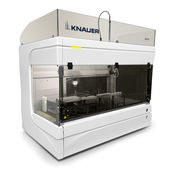
AZURA Purifier + LH 2.1 by KNAUER
Preparative Liquid Chromatography - New platform for more throughput
Save time and improve reproducibility during purification

Get the analytics and lab tech industry in your inbox
By submitting this form you agree that LUMITOS AG will send you the newsletter(s) selected above by email. Your data will not be passed on to third parties. Your data will be stored and processed in accordance with our data protection regulations. LUMITOS may contact you by email for the purpose of advertising or market and opinion surveys. You can revoke your consent at any time without giving reasons to LUMITOS AG, Ernst-Augustin-Str. 2, 12489 Berlin, Germany or by e-mail at revoke@lumitos.com with effect for the future. In addition, each email contains a link to unsubscribe from the corresponding newsletter.
